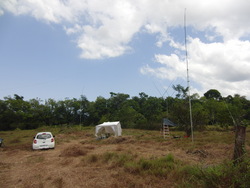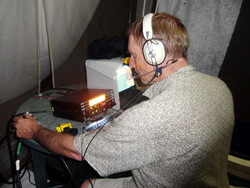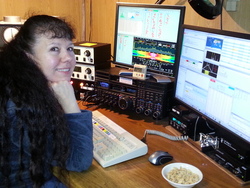 February 24, 2016 Editor: Paul Bourque, N1SFE | ||||
IN THIS ISSUE
NEW HF OPERATORS -- THINGS TO DO The ARRL DX Phone contest is coming up the weekend of March 5. The conditions for the CW contest (just completed) were pretty darned good, and there will be plenty of DX stations to work. Beforehand, how about checking your microphone and compression levels of your transmit audio, to ensure that it's accomplishing your goals? If you've changed headsets or microphones, if you've changed your shack's acoustics, if you are using higher power than previously, even if you've changed your power supply for your rig, you may need to adjust the microphone gain levels and amount of compression that you're using, to ensure minimum distortion and maximum effectiveness. Some rig manufacturers supply detailed instructions on how to adjust their equipment, while others leave you to fend for yourself. Jim Brown, K9YC, has written an article for the March-April 2016 issue of NCJ entitled, "Clean, Punchy, Competitive Contest Audio Without Splatter," which pretty much sums up everything that you should hope to achieve. Additionally, AB4OJ/VA7OJ has a web page on the general procedure to adjust for more "talk power" if you have a minimum of test equipment -- a power meter and receiver. February 27, the NAQP RTTY contest, will be a good bet for lots of contest activity; also don't forget that the South Carolina and North Carolina QSO Parties are on consecutive days that weekend. Idaho QSO Party Participants: The "Contest Corral -- March 2016" in the March issue of QST contains an incorrect Sponsors Website listing for the Idaho QSO Party. The correct listing is http://idahoarrl.info/qsoparty/rules.htm. "High Performance RX Antennas for a Small Lot" by Jose "JC" Carlos, N4IS, will be the topic of a webinar sponsored by the World Wide Radio Operators Foundation. "JC will look at basic concepts of RX antennas and share his experiences with low band RX antennas on a small lot, including the Waller Flag." Date/Time: March 3, 9 PM EST (March 4 - 0200 UTC). Registration is required. (Ken, K4ZW) Complete information for all contests follows the "Conversation" section February 25 February 26 February 27 February 28 March 1 March 2 March 3 March 4 March 5 March 6
March 7 March 8 March 9 Here's a fun and perhaps apocryphal story from some years ago of a surplus 6H6 being used for a critical system on a naval destroyer. You may recall that in August, 2015, the FCC proposed a rule that would compel manufacturers of Wi-Fi hardware to "demonstrate that the device contains security features to prevent the loading of software that would allow the radio to operate in violation of the Commission's rules." There are a number of Amateur Radio projects like HSMM-Mesh that take advantage of off-the-shelf Wi-Fi hardware in combination with project-specific firmware loaded on that hardware. At the time of the proposed ruling, there was speculation that the ruling could lead to manufacturers disallowing independent firmware usage so that they would satisfy the rules, resulting in a chilling effect for any projects that used independent firmware. The FCC later clarified what it meant, due to a large amount of feedback. Recently, TP-Link, a hardware vendor for Wi-Fi networking gear, started preventing the installation of non-standard firmware on some of its devices, stating it is due to the "FCC Regulations." That they are preventing upgrades is factual, however attributing the actual reason to proposed FCC regulations may just be convenient. There's not enough information to know for sure yet. Some hardware vendors are conflicted about the usage of third-party firmware for their products, as on the one hand it has the potential to sell more hardware and make products more mainstream, while on the other hand, it can relieve artificial firmware limitations intended to compel purchase of more expensive products. For more information on the evolving situation, try LibrePlanet.org, check out the Slashdot discussion, and see the website http://www.SaveWifi.org (and associated Save Wi-Fi 2 GoFundMe). The N3FJP logging program is growing an API (Application Programming Interface)! Starting in February 2016, functionality that will enable other programs to "talk" to the N3FJP logging program will start to be incorporated in the software. Initial functionality includes the ability to get/set text entry fields, get/set the frequency, band, mode, log a contact, check for dupes, and more. See the N3JFP website for more information. Russian scientists are combining memristors to fashion neural networks, realizing what has been described as a "Perceptron" by Marvin Minsky. Memristors are relatively new, but it's their use in "neuromorphic networks" that is novel. While a single-layer perceptron has been constructed, future multi-layer perceptrons would find application in machine learning and machine vision. A typical member of the "Maker" movement has a lot of the same characteristics of a typical Amateur Radio experimenter and builder -- including willingness to build their own equipment and projects using what's on hand, or using what can be gleaned from re-purposing other technology. Now, some makers are discovering ham radio. Website of the Week - - https://www.nationalhearingtest.org The National Hearing Test is a scientifically validated means of testing for hearing loss via telephone. Partially funded by the NIH, described in the Washington Post, on NPR, and via the National Hearing Test web site, you can use the results to determine whether or not it may be prudent to follow up with an audiologist. The testing fee is $5, however if you are an AARP member, you may be able to perform the test for free. The test itself uses spoken numbers combined with varying amounts of noise -- something phone operators should be familiar with. It's a device that is temporarily installed on a tower to lift tower sections, masts, antennas, and other items. It typically consists of a pulley atop a hollow pole. At the opposite end of the pole from the pulley is a clamp or other device that allows attachment to the tower. A rope or cable goes from the load, over the pulley, and through the pole. K7NV provides a nice diagram of gin pole use on his website.
Rich, N6KT, was TO2A in last fall's CQWW SSB 2015 Contest: "Many thanks to FY5SE and FY5YR for their great assistance!" For the ARRL DX SSB, he's heading to HK1NA. A raccoon climbed nearly 700 feet up a Toronto tower, and then back down. Unassisted. Social media has made the critter famous. Perhaps she can be trained as a tower work assistant? NASA has made a time-lapse movie of 1 year's observations from its Solar Dynamics Observatory. Flares, ejections, its all here; each frame represents 2 hours in the life of the sun. If you have the capability to display it, you can also download a 4K version (3840 x 2160 at 29.97 frames per second). (Dennis, N6KI) Don, N4KC, writes: "The movie Frequency, which, as you may recall, featured Amateur Radio very prominently, is now being turned into a television series. I wonder if this means we can add "decade" stickers to our DXCC certificates when we work DX from the past and future! Or participate in the ARRL DX Contest in, say, 1974..."
Worked All Europe DX Contest (WAEDC) results are available for all modes. This could also be a fine time to check out recent contest result postings at 3830scores.com. Convert those Cut Numbers In the recent ARRL International DX Contest, some CW operators were sending cut numbers, which are shorter letter abbreviations for numbers. For example, for a power level of 99 watts, "NN" could be sent. For 100, "1TT", or even "ATT". Before submitting your log, it's prudent to convert these to the numeric equivalent. If a cut number is entered for the zone, your logging progam may not even accept it. Hard-drawn copper wire has traditionally been used for some electrical transmission line and antennas, where its greater tensile strength allows less sag. It can be difficult to work with, and can be hard to find, though at least one source has it in both stranded and solid. For long spans with minimal sag, copper-coated steel may be a better choice. Using a Raspberry Pi computer and some switchable filters, it's possible to build a camera that allows one to view images captured using polarized light (PDF). Polarized sunglasses can help you see fish through the glare reflecting from water; using variations on this theme, it's possible to use this device to detect man-made materials, chemical plumes, etc. The author of the paper is N2QG. Building antennas for higher frequencies may require bending aluminum rod. A tool that you can build yourself may be helpful for consistent bends. Foamed Copper may be a better heat conductor than solid, as it has greater surface area for heat exchange. (Ward, N0AX) Careful with those network-enabled devices! Make sure you know what you're putting on the Internet. Old-CPU nostalgia: One company has realized a pin-signal-level replacement for an 8088 using an relatively inexpensive FPGA. Of course, other CPUs and even whole computers have been re-implemented using FPGAs: 6502: Apple II FPGA, generic 6502, or even a PDP-11. Here are some techniques tempered with humor that you can use to get soldered components off that PC board, provided by one of the principals at Elecraft. Could you use a Bluetooth switch with your computer? It turns out that under-$3 button hardware can link to your computer, emulating a keypress. These could be handy for some uses in the shack. Known Unknowns A couple of weeks ago, I was chatting with a colleague about what it would take to enable remote operation of our home stations so that we can use them from anywhere. The conversation eventually turned to the nitty-gritty details of how we could access our ham gear through our home network firewalls. My colleague mentioned that he worked with someone that thought you "didn't have to worry about using firewalls, because what is someone going to do anyway?" Being involved in the computer industry, I was taken aback; I didn't have an immediate answer to this, so alien was this opinion to me. I couldn't say nothing. All I could muster at the time was. "I think that's a really bad idea, there are all sorts of threats you are not aware of," while thinking, "don't exchange any USB storage devices with THAT guy. Remember to not open any of his e-mail attachments, either." What would have been a more comprehensive response? First, the answer to, "what is a bad guy going to do, anyway?" The smug but accurate answer is, "anything they can." It's not just the good guys that read about how the NSA exploits networks; the bad guys do too, and they write automated tools to do their work. Initially, their army of script-driven robot attackers look for network devices that are vulnerable to gain a toehold. There are plenty of devices that are potentially vulnerable; there's even a search engine that will help find them by the message they use to self-identify. Some network routers, firewalls, and cable modems, have vulnerabilities. Exploits and vulnerabilities are even bought and sold among the black hats. All it takes is one device that's vulnerable, and some unwanted software is running on that device making it capable of launching attacks on all of the other devices on your network. Compromised computers will be scanned for financial information; keystroke capture software may be installed so everything that's typed gets sent somewhere for later analysis; new root certificates may get installed, which will allow further nefarious software to be installed when you browse the web. You could suddenly be be locked out of all of your files, including your electronic logbook, or be sending spam e-mail to all of your ham friends in your address book. You could become an electronic pariah. The bad guys could also get access to whatever devices are running your ham gear, but they'd likely prefer your bank accounts and your identity information. Even if there are laws in place to protect you financially from identity theft, it is a long and arduous process to put your financial and virtual self back together. Security is all about cost-benefit trade-offs -- you want to be as costly and difficult a target as possible for a potential hacker. Understand and implement security practices that apply to your situation. In general, protect yourself however you can. Use strong passwords. Change default passwords. Keep your software and hardware up to date. Scan for viruses and other malware. Back up your data. Use a firewall, and don't open any more ports in your firewall than necessary. See you in the NAQP RTTY? 73, Brian N9ADG PS. Send your contest-related pictures, links, humor, press releases, and comments to contest-update@arrl.org. 25 Feb - 9 Mar An expanded, downloadable version of QST's Contest Corral in PDF format is available. Check the sponsor's website for information on operating time restrictions and other instructions. HF CONTESTS CWops Mini-CWT Test, Feb 24, 1300z to Feb 24, 1400z, Feb 24, 1900z to Feb 24, 2000z, Feb 25, 0300z to Feb 25, 0400z; CW; Bands: 160, 80, 40, 20, 15, 10m; Member: Name + Member No., non-Member: Name + (state/province/country); Logs due: February 27. VHF+ CONTESTS See NCCC Sprint Ladder, North Carolina and South Carolina QSO Parties, above. 25 Feb - 9 Mar 2016 February 25, 2016 February 26, 2016 February 27, 2016 February 28, 2016 February 29, 2016 March 1, 2016 March 2, 2016 March 4, 2016 March 6, 2016 March 7, 2016 March 8, 2016 ARRL Information Click here to advertise in this newsletter, space subject to availability. Your One-Stop Resource for Amateur Radio News and Information ARRL membership includes QST, Amateur Radio's most popular and informative journal, delivered to your mailbox each month. Subscribe to NCJ -- the National Contest Journal. Published bimonthly, features articles by top contesters, letters, hints, statistics, scores, NA Sprint and QSO Parties. Subscribe to QEX -- A Forum for Communications Experimenters. Published bimonthly, features technical articles, construction projects, columns and other items of interest to radio amateurs and communications professionals. Free of charge to ARRL members: Subscribe to The ARRL Letter (weekly digest of news and information), the ARES E-Letter (monthly public service and emergency communications news), Division and Section news -- and much more! ARRL offers a wide array of products to enhance your enjoyment of Amateur Radio. Visit the site often for new publications, specials and sales. Donate to the fund of your choice -- support programs not funded by member dues! Reprint permission can be obtained by sending email to permission@arrl.org with a description of the material and the reprint publication. ACKNOWLEDGMENTS ARRL Contest Update wishes to acknowledge information from WA7BNM's Contest Calendar and SM3CER's Contest Calendar. | ||||









